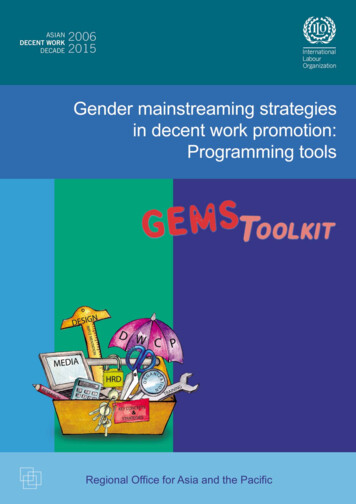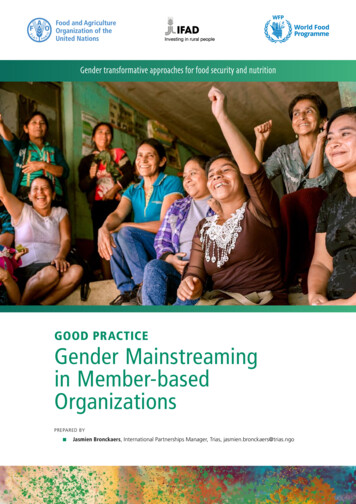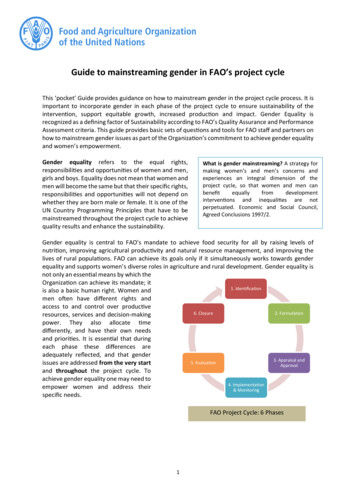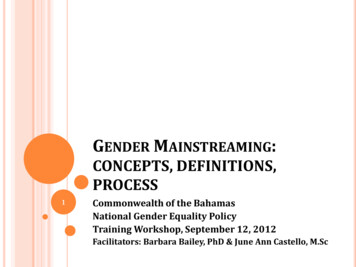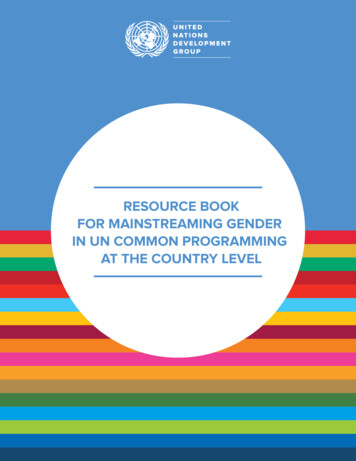
Transcription
RESOURCE BOOKFOR MAINSTREAMING GENDERIN UN COMMON PROGRAMMINGAT THE COUNTRY LEVEL
Resource Book for Mainstreaming Gender in UN Common Programming at the country level – 2017ContentsAbbreviations and AcronymsFigures, Boxes and TablesAcknowledgements1. Gender Equality in the 2030 Agenda for Sustainable Development1.1 Introduction to the Resource Book1.2 Leveraging the Global Normative Framework1.3 The QCPR and Gender Equality1.4 The New UNDAF Guidance and its Programming Principles1.5 Gender Mainstreaming: Multiple-Track Strategy and UN System Accountability2. Gender Mainstreaming in the UNDAF Roadmap2.1 What is the UNDAF Roadmap?2.2 Considerations for Mainstreaming Gender in the Roadmap2.3 Checklist on Gender Mainstreaming in the Roadmap3. Gender Mainstreaming in the UNDAF Common Country Analysis3.1 What is the UNDAF Common Country Analysis?3.2 Considerations for Mainstreaming Gender in the Common Country Analysis3.3 Checklist on Gender Mainstreaming in the Common Country Analysis4. Gender Mainstreaming in the UN Vision 20304.1 What is the UN Vision 2030?4.2 Considerations for Mainstreaming Gender in the UN Vision 20304.3 Checklist on Gender Mainstreaming in the UN Vision 20305. Gender Mainstreaming in UNDAF Development5.1 What is UNDAF Development?5.2 Considerations for Mainstreaming Gender in UNDAF Development5.3 Checklist on Gender Mainstreaming in UNDAF Development6. Gender Mainstreaming in UNDAF Financing6.1 What is UNDAF Financing?6.2 Considerations for Mainstreaming Gender in UNDAF Financing6.3 Checklist on Gender Mainstreaming in UNDAF Financing7. Gender Mainstreaming in UNDAF Coordination and ManagementArrangements7.1 What are UNDAF Coordination and Management Arrangements?i
Resource Book for Mainstreaming Gender in UN Common Programming at the country level – 20177.2 Considerations for Mainstreaming Gender in UNDAF Coordination and Management7.3 Checklist on Gender Mainstreaming in UNDAF Coordination and Management8. Gender Mainstreaming in UNDAF Results Monitoring, Reportingand Evaluation8.1 What is UNDAF Monitoring, Reporting and Evaluation?8.2 Considerations for Mainstreaming Gender in UNDAF Monitoring, Reporting andEvaluation8.3 Checklist on Gender Mainstreaming in UNDAF Monitoring, Reporting and EvaluationAnnex 1. GlossaryAnnex 2. Key Resourcesii
Resource Book for Mainstreaming Gender in UN Common Programming at the country level – 2017Abbreviations and -SWAPUNUNCTUNDAFUNDAPUNDGUNPAFUNSCRUPRAddis Ababa Action AgendaCommon Budgetary FrameworkCommon Country AssessmentChief Executive BoardConvention on the Elimination of All Forms of Discrimination against WomenCivil Society OrganizationCommission on the Status of WomenDelivering as OneDevelopment Finance AssessmentDisaster Risk ReductionEconomic and Social CouncilGender-based ViolenceGender Equality and Women’s EmpowermentGender Needs AssessmentGender-Responsive BudgetingGender Theme GroupHigh Level Committee on ProgrammeHead of AgencyInternational Conference on Population and DevelopmentInternational Financial InstitutionJoint Gender ProgrammeManagement and Accountability SystemMultilateral Development BankMillennium Development GoalMillennium Development Goal Achievement FundMonitoring and EvaluationNational Action PlanNon-Governmental OrganizationNational Women’s MachineryOfficial Development Assistance(Lao) People’s Democratic RepublicParticipatory Gender AuditPeer Support GroupQuadrennial Comprehensive Policy ReviewQuality Support and AdviceResults-based ManagementResident CoordinatorSustainable Development GoalsStandard Operating ProceduresSystem-wide Action PlanTheory of ChangeTerms of ReferenceUN System-wide Action PlanUnited NationsUnited Nations Country TeamUnited Nations Development Assistance FrameworkUnited Nations Development Assistance PlanUnited Nations Development GroupUnited Nations Partnership FrameworkUnited Nations Security CouncilUniversal Periodic Reviewiii
Resource Book for Mainstreaming Gender in UN Common Programming at the country level – 2017Figures, Boxes and TablesFigure 1. Steps in Developing and Managing an UNDAFTable 1. Multiple-track approach in the UNDAF Results Matrix: FYR MacedoniaTable 2. Methodologies and Tools for Costing Gender EqualityTable 3. Key Steps in Joint Gender ProgrammesTable 4. Comparison of Qualitative and Quantitative IndicatorsTable 5. Minimum Set of Gender Indicators, by DomainBox 1. An Engendered UNDAF Roadmap in Papua New GuineaBox 2. Gender Advocacy with UNCTs and Government PartnersBox 3. Using the Gender Equality Capacity Assessment Tool to Support the UNDAF in NepalBox 4. A New UNCT SWAP-Scorecard to Enhance Gender Mainstreaming at the CountryLevelBox 5. ILO Participatory Gender AuditBox 6. Sex-Disaggregated Data in CCAs in the Latin American and the Caribbean RegionBox 7. Gender Analysis in the Cabo Verde CCABox 8. Potential Areas of UN System Comparative Advantage on Gender EqualityBox 9. Using FutureScaper to Forecast Gender Equality Outcomes in Lao PDRBox 10. Questions for the Engendering of the Vision 2030Box 11. Theory of Change for Gender Equality in LiberiaBox 12. Mainstreaming Gender in a Delivering as One Context: the case of TanzaniaBox 13. Advocacy Strategies for Gender Advocates in Strategic Planning ProcessesTheory of Change for Gender Equality in LiberiaBox 14. Questions to develop a Financing StrategyBox 15. Calculating the Financing Gap to Implement the NAP for Gender Equality inKyrgyzstanBox 16. Tracking Resources through a Gender Marker in VietnamBox 17. GTG Support to UNDAF Implementation: BelarusBox 18. Gender Mainstreaming through the Peer Support Group in EECABox 19. Success Factors in Making Joint Gender Programmes WorkBox 20. Mainstreaming Gender into an Environment and Climate Change Joint ProgrammeBox 21. Core Set of Statistical Indicators on Violence Against WomenBox 22. Gender-Sensitive Data Collectioniv
Resource Book for Mainstreaming Gender in UN Common Programming at the country level – 2017AcknowledgementsSince its initial development in 2014, the Resource book for mainstreaming gender in UNcommon programming at the country level has been a key knowledge product for UN staff,especially those supporting regional UNDGs and UNCTs in mainstreaming gender in theUNDAF.Following the adoption of the 2030 agenda for sustainable development in September 2015,as well as the roll out of the new UNDAF guidance in February 2017, the UNDG embarked inthe updating of the Resource Book. Its structure and content were revised to fully align withthe SDGs, the new programming guidance to UNCTs, and the updated UNCT SWAPScorecard. The document features updated checklists at the end of every section, drawingfrom lessons learned, as well as a new set of examples on gender mainstreaming across thevarious stages of the UNDAF.Within the UNDG, the work was led by UN Women and UNFPA, who also provided fundingfor the update. Michele Ribotta, adviser at the UN System Coordination Division of UNWomen, and Eva Johansson, adviser at the Gender, Human Rights and Culture Branch,Technical Division of UNFPA, coordinated the updating process. They ensured the inclusionof UNDG member entities in the exercise, and provided support and oversight to AnnaliseMoser, the gender and development expert who conducted the updating work and compiledthe Resource Book.Regional experts of UN Women and UNFPA ensured buy-in from regional UNDGs, providingsubstantive contribution and advise on the content update, and helping identify experiencesand good practices from UNCTs across regions. They include, for UN Women: ElisabethDiaz, Janneke Kukler, Florence Hamimi, Estela Bulk, Fumie Nakamura, Hulda Ouma, andAlethia Jimenez. For UNFPA: Neus Bernabeu; Ingrid Fitzgerald; Nigina Abaszade;Seynabou Tall; Enshrah Ahmed; Idrissa Ouedraogo;At UN Women HQs, Ingrid Arno ensured communication with the Gender Equality Task Team,while Elwira Zych and Sooyeon Kim provided administrative support.Brianna Harrison in UN DOCO provided advice and support during the final stages of theupdating process.v
Resource Book for Mainstreaming Gender in UN Common Programming at the country level – 20171. Gender Equality in the 2030 Agenda for SustainableDevelopment1.1 Introduction to the Resource BookThis Resource Book supports the prioritization and mainstreaming of gender equality issuesin UN common programming processes at the country level, in the context of the 2030 Agendafor sustainable development, the Sustainable Development Goals, and the 2017 UnitedNations Development Assistance Framework (UNDAF) Guidance. Rather than providingprescriptive guidance, the Resource Book is intended as a practical knowledge tool based onexisting guidance combined with field experiences, and as a resource for gender specialistsand gender advocates who are responsible for mainstreaming gender into United Nations(UN) common programming processes at the country level.Depending on the country context, this Resource Book aims to become a practical knowledgetool for: UN gender experts and gender focal points within UN organizations; regional genderadvisors and experts (including members of peer support groups within regional UNDGs);members of UN gender theme groups, programme management teams and UNDAFoutcome/results groups. It is intended to be used alongside the UNDAF Guidance andassociated companion pieces.Section 1 of the Resource Book provides an overview of gender equality as situated within the2030 Agenda and the Sustainable Development Goals, the 2016 Quadrennial ComprehensivePolicy Review, and especially the new features of the updated UNDAF guidance, as well asthe concept of gender mainstreaming within the UN system. The remainder of the ResourceBook addresses each of the key steps of the UNDAF process, with each section providing anoverview of those steps, considerations for mainstreaming gender equality, and a checklist.Section 2 addresses the UNDAF roadmap; section 3 examines the UNDAF common countryanalysis; section 4 looks at the UN Vision 2030; section 5 considers the development of theUNDAF; section 6 addresses UNDAF financing; section 7 covers coordination andmanagement arrangements; and section 8 considers UNDAF monitoring, reporting andevaluation. A glossary of key gender-related terms and a list of key resources are among theAnnexes provided.1.2 Leveraging the Global Normative Framework2015 was a landmark year for gender equality. The 20-year review and appraisal of the BeijingPlatform for Action provided a global assessment of progress on achieving gender equality,women’s empowerment and the realization of women’s human rights, as well as importantlessons learned in order to accelerate the full and effective implementation of the Platform forAction. Member States also reached historic agreement on the 2030 Agenda for SustainableDevelopment (2030 Agenda), the Addis Ababa Action Agenda (the AAAA) on Financing forDevelopment and the Paris Agreement on climate change. Gender equality and human rightscommitments across these agreements are key, alongside previous commitments to eradicatepoverty, reduce inequalities, build peaceful societies and ensure environmental sustainabilityand disaster risk reduction (DRR) through a process of transformative change across thehumanitarian-development continuum in commitments such as the Sendai Framework, thelandmark United Nations Security Council Resolution (UNSCR) 1325 and its successorresolutions (1820, 1888, 1889, 1960, 2106 and 2122) on Women, Peace and Security, andthe commitments from the World Humanitarian Summit. Delivering on these promises willrequire anything but a ‘business as usual’ approach. In line with commitment to nationalownership, the UN system is expected to support countries in the implementation of the 20306
Resource Book for Mainstreaming Gender in UN Common Programming at the country level – 2017Agenda, including on the gender equality commitments across the 17 SustainableDevelopment Goals (SDGs).Gender equality, women’s rights and women’s empowerment are essential ingredients increating a more equitable and just world for all. The 2030 Agenda reaffirmed that genderequality is a condition sine qua non for sustainable development and, at the same time, anindispensable outcome of it. The UN system has a critical role to play in ensuring that a genderperspective is properly reflected in national development processes, and a responsibility toaddress gender equality thorough operational activities for development at the country level.The 2030 Agenda, along with its 17 SDGs, prioritizes the realization of gender equality andwomen’s rights in a cross-cutting manner across its economic, social and environmentaldimensions, along with the stand-alone goal on gender equality and the empowerment ofwomen and girls (SDG 5). With the 2030 Agenda’s shift to a multi-dimensional and integratedapproach to development issues, there are opportunities to mainstream gender in a moreholistic and systematic way.A central and defining call of the 2030 Agenda is the commitment of Member States ‘to leaveno one behind’, to ‘reach the furthest behind first’ and to address inequalities both within andbetween states. This requires the UN system to deepen its analysis to tackle the root causesof multiple discrimination and structural inequalities, as well as to promote the principles ofequality and non-discrimination, including the concept of substantive equality, ensuringequality of outcomes and results for all groups of women and girls. This could include, forexample, addressing structural barriers, reversing unequal distributions of power, resourcesand opportunities, and/or challenging discriminatory laws, social norms and stereotypes thatperpetuate inequalities and disparities.1 The Agenda positions the Beijing Platform for Actionas a foundational framework, while the Convention on the Elimination of all Forms ofDiscrimination against Women (CEDAW), remains central to the realization of women’shuman rights and the achievement of the 2030 Agenda. Other relevant instruments are alsoembodied in the Agenda, including human rights commitments and the InternationalConference on Population and Development (ICPD).The sixtieth session of the Commission on the Status of Women (CSW60) adopted acomprehensive roadmap for the gender-responsive implementation of the 2030 Agenda. Itreaffirmed that the full, effective and accelerated implementation of the Beijing Declarationand Platform for Action will make a crucial contribution to the implementation of the 2030Agenda for Sustainable Development that will leave no one behind. It also acknowledged thevulnerability and marginalization that many women and girls experience owing to multiple andintersecting forms of discrimination, as well as calling upon the UN system to support thegender-responsive implementation of the 2030 Agenda, including through strengtheningnormative and policy frameworks, financing for gender equality and women’s empowerment,and promoting leadership and women in decision-making as well as data and evidencestrengthening.1.3 The QCPR and Gender EqualityThe Quadrennial Comprehensive Policy Review2 (QCPR) gives guidance to the UNdevelopment system for ensuring greater coherence and integrated support across the SDGs;this is a key theme in terms of gender equality and the empowerment of women and girls, asthese priorities cross-cut the majority of the SDGs.1See Annex 1 for a definition of substantive gender equality.The QCPR is the primary policy instrument of the General Assembly to guide the operationalactivities for development of the UN System. For more information click here.27
Resource Book for Mainstreaming Gender in UN Common Programming at the country level – 2017The 2016 QCPR (A/71/243) places strong emphasis on the fundamental importance ofpromoting gender equality and empowerment of all women and girls, noting the multipliereffect for achieving sustained and inclusive economic growth, poverty eradication andsustainable development. It calls upon all entities of the United Nations development systemto continue to promote women’s empowerment and gender equality by enhancing gendermainstreaming through the full implementation of the System-wide Action Plan (SWAP) onGender Equality and the Empowerment of Women, as well as through the United NationsCountry Team (UNCT) performance indicators for gender equality and the empowerment ofwomen (the “scorecard”)3.The QCPR also highlights the importance of gender-responsive performance managementand strategic planning, the collection, use and dissemination of sex-disaggregated data,reporting and resource tracking, and drawing on available gender expertise in the system atall levels, including in UN Women, to assist in mainstreaming gender equality in thepreparation of the UNDAF or equivalent planning framework. This builds upon the 2012 QCPR(A/RES/67/226), which urged accountability for gender equality and the empowerment ofwomen, and greater effectiveness in the context of the UNDAF.The new QCPR also recognizes normative support as a key area for enhancing nationalcapacities and development results. Linking the normative mandates of the UN system withits operational activities becomes critical, especially for UNCTs. A series of country casestudies commissioned by the UNDG illustrate how UNCTs address normative and operationallinkages, including with regards to human rights, gender equality and environmentalsustainability.1.4 The New UNDAF Guidance and its Principles for Integrated ProgrammingCommon approaches at the corporate level support gender equality and women’sempowerment in the implementation of the 2030 Agenda. The UN System Chief ExecutivesBoard for Coordination (CEB) developed a set of common principles for an integrated andcoordinated approach to supporting the implementation of the Agenda by member states,including “promoting gender equality and the empowerment of women and girls, addressinginequality, leaving no one behind and reaching the furthest behind first”. Furthermore, the CEBdeveloped a shared UN Framework for Action around inequalities and non-discrimination thatincludes the broader concept of equity, and addresses both horizontal and vertical inequalitiesand inequalities of opportunities and outcomes. The UNDG has also prioritized support toUNCT efforts to mainstream gender and monitor gender equality benchmarks, through itsvarious working mechanisms and the regional UNDGs, that support gender mainstreaming inthe UNDAFs through their Peer Support Groups (PSG) and dedicated working groups ongender.The UNDAF4 is the strategic programme framework that describes the collective response ofthe UN system to national development priorities, taking place typically every five years. TheUNDAF provides a system-wide overview of key UN activities and functions at country level,in support of the national policies, priorities and plans of programme countries, whilst ensuringcoordination, coherence, effectiveness and efficiency for maximum impact. The 2017 UNDAFguidance developed by the UNDG is based on the integration of four principles for integratedprogramming, each of which has critical implications for gender equality:3See box 4 for more details on the new UNCT SWAP scorecardThe UN Development Assistance Framework (UNDAF) is the common programming framework mostcommonly used by UNCTs, including under the Delivery as One modality. Many countries use differentnames to identify those frameworks. For the sake of clarity, this Resource Book refers throughout tothe UNDAF, but applies to the full range of common programming frameworks in use.48
Resource Book for Mainstreaming Gender in UN Common Programming at the country level – 2017 “Leave no one behind”: As the core principle of the 2030 Agenda, it constitutes theoverarching programming principle for all country contexts. Leaving no one behind andreaching the furthest behind first is crucial for gender equality as women are oftendisproportionately represented among the most marginalized, discriminated againstand excluded, as well as being more at risk from conflict, climate change, or naturaldisasters. Human rights, gender equality and women’s empowerment: Placing genderequality at the heart of UNDAF programming, this principle includes addressing rootcauses of inequalities and discrimination based on gender in addition to other factors,promoting active and meaningful participation of women as well as men, andspecifically reducing gender inequalities by empowering all women and girls. Thisprinciple further includes the use of CEDAW, the Universal Periodic Review (UPR) andother international human rights instruments and their reporting mechanisms inplanning and monitoring of the UNDAF. The human rights and gender equalityagendas are interlinked, with both agendas reinforcing each other. Sustainability and resilience: All UNDAF interventions seek to reduce risks and buildresilience. They take into account how the legal, policy and institutional environmentas well as economic and social patterns affect the resilience of communities, especiallyfor vulnerable and excluded groups. Gender equality and women’s participation arecatalytic components of successful social, economic and environmental resilience,disaster risk reduction and sustainability strategies, and sustainable peace building,with women and girls experiencing a disproportionate impact of shocks, as well asproviding specific knowledge, agency and collective action in work to promotesustainability and resilience. Accountability: UNDAFs seek to promote accountable societies, including throughimproved measurement and reporting on results, promoting citizens’ participation indecision-making, and supporting the development and use of transparent and robustdata and information for policy formulation, programme design and implementation.This includes measures such as using indicators disaggregated by sex, age, disabilityand other diversities and gender-specific indicators involving women’s rightsorganisations in monitoring and decision-making, supporting human rights monitoringprocesses at national level, and strengthening national gender equality mechanismsto monitor results; internally, the UNCT SWAP-Scorecard is a key element ofstrengthening UN accountability to gender equality.These principles are supported by six integrated programming approaches, with thefollowing relevance to gender mainstreaming: Results-focused programming: A context-based gender analysis informs theCommon Country Analysis (CCA), drawing on and supporting gender-sensitive dataand evidence; gender equality issues are also addressed during the selection of priorityissues and target groups. Capacity development: Capacity development support implies addressing thecapacity needs of key national stakeholders, including women’s civil societyorganizations and national machineries for gender equality, as well as strengtheningthe policy environment with regards to gender equality. Risk informed programming: Must include analysis of how risks impact men andwomen, gender-specific risks such as gender-based violence (GBV), and the9
Resource Book for Mainstreaming Gender in UN Common Programming at the country level – 2017differentiated abilities of women and men to adapt to, mitigate and build resilience torisks.5 Development, humanitarian and peacebuilding linkages: Recognises theimportance of gender equality and women’s leadership and decision-making inhumanitarian action, peacebuilding and development practice, in addition toaddressing the protection of women and girls from violence – especially GBV – andthe provision of services to women affected by conflict.6 Coherent policy support: Refers to the need to ensure that gender equality andwomen’s empowerment (GEWE) principles are mainstreamed across all areas ofpolicy coherence – aligning with national policy and legislative frameworks for genderequality, as well as in cross-sectoral work and approaches. Partnerships: Prioritizes partnerships with women’s civil society organizations (CSOs)and non-governmental organizations (NGOs), gender-focused research or privatesector institutions, workers’ organizations, as well as those working on gender equalityin national government across a variety of sectors.There are seven key steps in the development and management of an UNDAF, as establishedout in the new UNDAF Guidance; the roadmap, common country analysis, UN Vision 2030,developing the UNDAF, financing, coordination and management, and monitoring, reportingand evaluation (see Figure 1). The entry-points and issues associated with each of theseseven steps are addressed in detail in the later sections of this Resource Book.Figure 1. Steps in Developing and Managing an UNDAFRoadmapCommonCountryAnalysisUN Vision2030Developingthe dM&E1.5 Gender Mainstreaming: Multiple-Track Strategy and UN System AccountabilityGender mainstreaming, as a strategic approach for achieving the goal of genderequality, has been mandated in the UN system since the Beijing Platform for Action(1995) and the 1997/2 agreed conclusions of the Economic and Social Council(ECOSOC 1997/2), and subsequently across all of the major areas of work of the UNsystem. The ECOSOC defined gender mainstreaming as: a strategy for makingwomen’s as well as men’s concerns and experiences an integral dimension of thedesign, implementation, monitoring and evaluation of policies and programmes in allpolitical, economic and societal spheres so that women and men benefit equally andinequality is not perpetrated. The ultimate goal is to achieve gender equality.In this sense, gender is a social construction with structural effects on both women and men.These intersect with different socio-economic determinants and multiple diversities such as5See for example UN Women (2012). Gender and Conflict Analysis: Policy Briefing Paper, New York:UN Women and UNISDR, UNDP; and IUCN (2009). Making disaster risk reduction gender-sensitive:policy and practical guidelines, Geneva.6 See for example UN Women (2015). Preventing Conflict, Transforming Justice, Securing the Peace:A Global Study on the Implementation of United Nations Security Council resolution 1325. New York.10
Resource Book for Mainstreaming Gender in UN Common Programming at the country level – 2017age, geographic location, ethnic group, socio-economic status, disability, sexual orientationand gender identity. There is an ongoing agenda around masculinities and engaging men aspartners in work to address gender inequality. These issues need to be addressed withinongoing efforts to achieve gender equality and women’s empowerment, and in line with thecore 2030 Agenda principle of “leave no one behind”.The multiple-track (or ‘twin-track’)7 approach for gender mainstreaming is the UN system’sofficial strategy for achieving transformative change, and is also the strategy adopted in theSDGs; it incorporates both gender-targeted interventions to support gender equality andwomen’s empowerment in specific social groups, specific organizations and/or processes aswell as integrating gender perspectives in relevant areas, to ensure that gender equality isintegrated across the substantive work of all sectors; this is discussed in detail in GenderMainstreaming in Development Programming: Guidance Note8. Gender mainstreaming inthe context of the UNDAF therefore involves advocating, planning and programmingfor both interventions specifically targeting gender equality issues, as well asintegrating gender equality concerns across all other areas of the UNDAF.The ECOSOC, through its resolutions9, confirms guidance to the UN System to implementgender mainstreaming, specifically calling on the UN system to increase focus andinvestments on gender results at the outcome level. The UN system has reinforced itsaccountability instruments on gender in response to the ECOSOC resolutions on gendermainstreaming, through for example the 2006 Chief Executives Board policy, the UNCTSWAP-Scorecard, and the UN-SWAP. The latter two were updated to align with the SDGs,new QCPR and new UNDAF guidance. UN gender mainstreaming efforts also align with otherrelevant accountability mechanisms for gender equality in humanitarian action and disasterrisk reduction. A detailed list of key resources on gender mainstreaming is provided in Annex2.7See the glossary in Annex 1 for an explanation of key terms.The Guidance Note addresses gender mainstreaming in the current development context, providinggeneral guiding principles and key concepts, as well as highlighting issues related to mainstreaminggender in development programming; it should be consulted along with the present Resource Book inthe process of mainstreaming gender into common country programming.9See here for a list of ECOSOC resolutions on gender mainstreaming, and related reports of theSecretary General.811
Resource Book for Mainstreaming Gender in UN Common Programming at the country level – 20172. Gender Mainstreaming in the UNDAF Roadmap2.1 What is the UNDAF Roadmap?The UNDAF roadmap sets the stage for and outlines the UNDAF preparation process. TheUNCT and the government coordinating body prepare and agree on a roadmap aligning to thenational development planning process, as well as the 2030 Agenda, and laying out the stepsand milestones for the UNCT’s contribution to country analysis and UNDAF preparation. Theroadmap also identifies support needed from regional offices and headquarters.2.2 Considerations for Mainstreaming Gender in the RoadmapMainstreaming gender is more effective when it happens from the beginning of the roadmapphase of the UNDAF. Generic roadmaps will have a number of actions, including highlightingalignment wi
IFI International Financial Institution JGP Joint Gender Programme . Book addresses each of the key steps of the UNDAF process, with each section providing an . 1888, 1889, 1960, 2106 and 2122) on Women, Peace and Security, and the commitments from the World Humanitarian Summit. Delivering on these promises will require anything but a .



